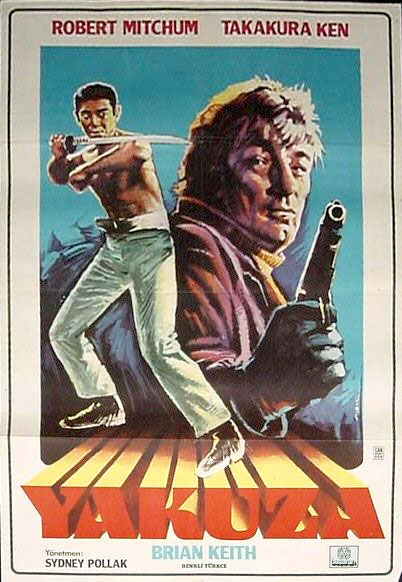
Robert Mitchum film kicks off Japan Society Yakuza series
THE YAKUZA (Sidney Pollack, 1975)
Japan Society
333 East 47th St. at First Ave.
Wednesday, March 9, $12, 7:30
Series runs March 9-19
212-715-1258
www.japansociety.org
 One of Hollywood’s first forays into the Japanese underworld has quite a pedigree — directed by Sydney Pollack (coming off his success with The Way We Were) and written by Robert Towne (who had just scribed Chinatown and Shampoo) and Paul Schrader (his first writing credit, to be followed by Taxi Driver). The great Robert Mitchum stars as Harry Kilmer, a WWII vet who returns to Japan thirty years later to help his friend George Tanner (Brian Family Affair Keith), whose daughter has been kidnapped. Kilmer thinks he can just walk in and walk out, but things quickly get complicated, and he ends up having to take care of some unfinished business involving the great Keiko Kishi (The Twilight Samurai). Kilmer and his trigger-happy young cohort, Dusty (Richard Logan’s Run Jordan), hole up at Oliver’s (Herb “Murray the Cop” Edelman), where they are joined by Tanaka (Ken Takakura) in their battle against Toshiro Tono (Eiji Hiroshima Mon Amour Okada) and Goro (James Flower Drum Song Shigeta) while searching for a man with a spider tattoo on his head. There are lots of shootouts and sword fights, discussions of honor and betrayal, and, in the grand Yakuza tradition, the ritual cutting off of the pinkie. The Yakuza kicks off the Globus Film Series “Hardest Men in Town: Yakuza Chronicles of Sin, Sex & Violence” on March 9 and will be followed by a Q&A with Schrader.
One of Hollywood’s first forays into the Japanese underworld has quite a pedigree — directed by Sydney Pollack (coming off his success with The Way We Were) and written by Robert Towne (who had just scribed Chinatown and Shampoo) and Paul Schrader (his first writing credit, to be followed by Taxi Driver). The great Robert Mitchum stars as Harry Kilmer, a WWII vet who returns to Japan thirty years later to help his friend George Tanner (Brian Family Affair Keith), whose daughter has been kidnapped. Kilmer thinks he can just walk in and walk out, but things quickly get complicated, and he ends up having to take care of some unfinished business involving the great Keiko Kishi (The Twilight Samurai). Kilmer and his trigger-happy young cohort, Dusty (Richard Logan’s Run Jordan), hole up at Oliver’s (Herb “Murray the Cop” Edelman), where they are joined by Tanaka (Ken Takakura) in their battle against Toshiro Tono (Eiji Hiroshima Mon Amour Okada) and Goro (James Flower Drum Song Shigeta) while searching for a man with a spider tattoo on his head. There are lots of shootouts and sword fights, discussions of honor and betrayal, and, in the grand Yakuza tradition, the ritual cutting off of the pinkie. The Yakuza kicks off the Globus Film Series “Hardest Men in Town: Yakuza Chronicles of Sin, Sex & Violence” on March 9 and will be followed by a Q&A with Schrader.
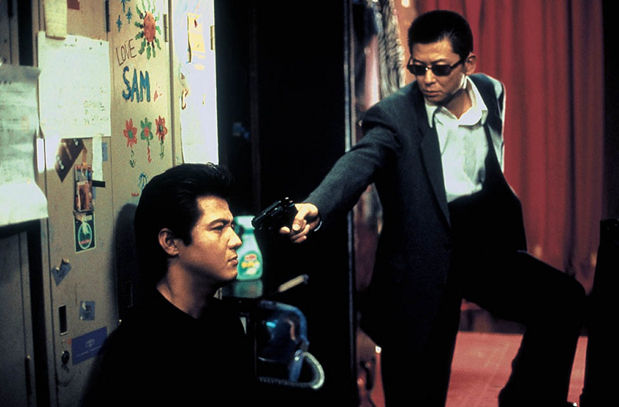
Takashi Miike will be at Japan Society on March 15 to introduce his 1999 Yakuza film, DEAD OR ALIVE
The series continues March 10 with the U.S. premiere of Onibi: The Fire Within (Rokuro Mochizuki, 1997), which will feature an introduction and lecture by Jake Adelstein, author of Tokyo Vice. On March 11, the screening of The Wolves (Hideo Gosha, 1971) will be followed by a Gangsta Party with High Teen Boogie. March 12 is “Honor Amongst Ruffians Saturday or: The Films You’ll Never Ever Find on DVD . . . Ever,” including the international premieres of The Walls of Abashiri Prison (Pt 3): Longing for Home (Teruo Ishii, 1965) and Brutal Tales of Chivalry (Kiyoshi Saeki, 1965), while March 13 is “A Dog-Eat-Dog World Sunday,” with screenings of three films, including Youth of the Beast (Seijun Suzuki, 1963). On March 15, the great one himself, Takashi Miike, in town for a five-day retrospective at Lincoln Center, will introduce his apocalyptic Dead or Alive (1999).The series concludes on March 19 with the New York premiere of Takeshi Kitano’s 2010 Yakuza thriller, Outrage: The Way of the Modern Yakuza. If you’ve never seen a Yakuza movie, you’re in for a treat. No mere ripoff of American gangster pictures, Yakuza films focus on a whole different level of honor and betrayal, violence and revenge.
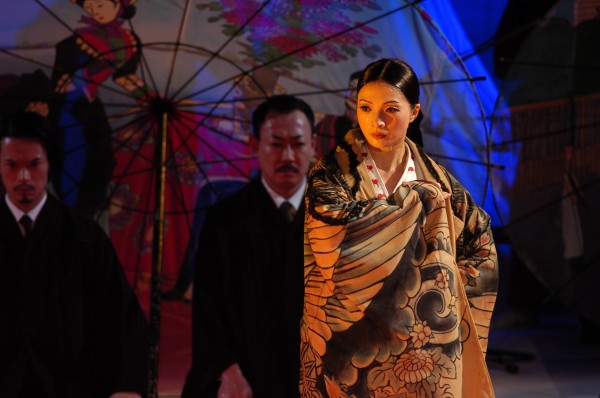

 The North American premiere of the wild and wacky, genre-iffic Milocrorze: A Love Story kicks off the tenth anniversary of New York City’s most exciting annual film series, the New York Asian Film Festival, running July 1-14 at Lincoln Center. Melding Michel Gondry with Quentin Tarantino and Takashi Miike filtered through Max Ophüls’s La Ronde and Jean-Pierre Jeunet’s Amélie, longtime commercial, video, and television director Yoshimasa Ishibashi makes his feature-film cinematic debut with this highly stylized three-part tale of love and romance. In the first section, seven-year-old salaryman Ovreneli Vreneligare, wearing one of the most charming costumes and hairstyles ever put on celluloid, falls in love with the beautiful, and adult, Milocrorze (Maiko) in a candy-coated fantasyland of lush colors and dreamlike sets. That bittersweet tale leads into the second part, in which bizarre youth counselor Besson Kumagi (Takayuki Yamada) abusively screams relationship advice to lonely boys over the phone, then breaks out into self-celebratory dance numbers with a couple of hot babes, a sort of Japanese version of Andy Kaufman’s Tony Clifton character. That story segues into the violent, vengeful mini-epic of rogue samurai Tamon (Yamada again), who starts out as a simple man who falls in love with Yuri the flower girl (Ann Ishibashi) but is soon trying to rescue her from a high-priced gambling and prostitution ring. Ishibashi then circles back to Milocrorze and Ovreneli Vreneligare (Yamada yet again, in his third role) years later for the tender finale. Milocrorze is a vastly entertaining, wonderfully absurd, and utterly ridiculous (and we mean that in a good way) exercise in multiple genres from the endlessly inventive Ishibashi. The samurai section goes on way too long, but otherwise this is a rousing success from start to finish, even when it is making absolutely no sense, which is very often. Milocrorze is the opening-night selection of NYAFF 2011, and both Ishibashi and Yamada will be at Lincoln Center on July 1 to participate in a postscreening Q&A; prior to the screening, Yamada will receive the Star Asia Rising Star Award. The film is being presented in conjunction with Japan Cuts: The New York Festival of Contemporary Japanese Cinema, screening at Japan Society on July 10, followed by a Q&A with Ishibashi. Keep watching twi-ny for more reviews of select films from our two favorite film festivals of the year.
The North American premiere of the wild and wacky, genre-iffic Milocrorze: A Love Story kicks off the tenth anniversary of New York City’s most exciting annual film series, the New York Asian Film Festival, running July 1-14 at Lincoln Center. Melding Michel Gondry with Quentin Tarantino and Takashi Miike filtered through Max Ophüls’s La Ronde and Jean-Pierre Jeunet’s Amélie, longtime commercial, video, and television director Yoshimasa Ishibashi makes his feature-film cinematic debut with this highly stylized three-part tale of love and romance. In the first section, seven-year-old salaryman Ovreneli Vreneligare, wearing one of the most charming costumes and hairstyles ever put on celluloid, falls in love with the beautiful, and adult, Milocrorze (Maiko) in a candy-coated fantasyland of lush colors and dreamlike sets. That bittersweet tale leads into the second part, in which bizarre youth counselor Besson Kumagi (Takayuki Yamada) abusively screams relationship advice to lonely boys over the phone, then breaks out into self-celebratory dance numbers with a couple of hot babes, a sort of Japanese version of Andy Kaufman’s Tony Clifton character. That story segues into the violent, vengeful mini-epic of rogue samurai Tamon (Yamada again), who starts out as a simple man who falls in love with Yuri the flower girl (Ann Ishibashi) but is soon trying to rescue her from a high-priced gambling and prostitution ring. Ishibashi then circles back to Milocrorze and Ovreneli Vreneligare (Yamada yet again, in his third role) years later for the tender finale. Milocrorze is a vastly entertaining, wonderfully absurd, and utterly ridiculous (and we mean that in a good way) exercise in multiple genres from the endlessly inventive Ishibashi. The samurai section goes on way too long, but otherwise this is a rousing success from start to finish, even when it is making absolutely no sense, which is very often. Milocrorze is the opening-night selection of NYAFF 2011, and both Ishibashi and Yamada will be at Lincoln Center on July 1 to participate in a postscreening Q&A; prior to the screening, Yamada will receive the Star Asia Rising Star Award. The film is being presented in conjunction with Japan Cuts: The New York Festival of Contemporary Japanese Cinema, screening at Japan Society on July 10, followed by a Q&A with Ishibashi. Keep watching twi-ny for more reviews of select films from our two favorite film festivals of the year.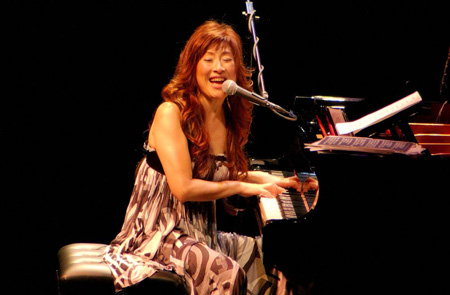
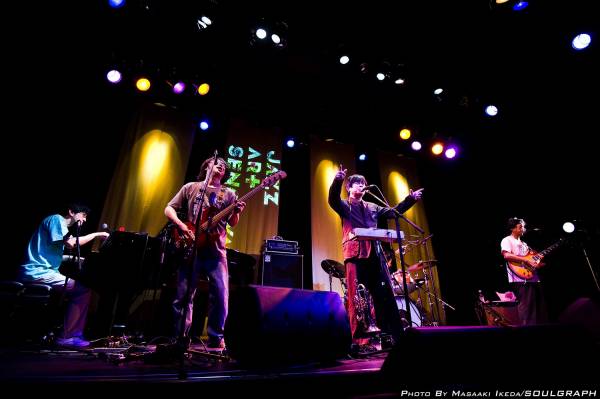


 In Takashi Miike’s Dead or Alive, the ultracool beginning and unforgettably bizarre ending are awesome; unfortunately, the long middle section lacks the excitement and originality of many of his other crime films, from Ley Lines (1999) and City of Lost Souls (2000) to Ichi the Killer (2001) and Izo (2004). The DVD comes with the following warning: “This motion picture contains explicit portrayals of violence; sex; violent sex; sexual violence; clowns and violent scenes of violent excess, which are definitely not suitable for all audiences…. Enjoy at your own risk.” Dead or Alive lives up to its billing with plenty of drugs, sex, violence, blood, gluttony, stabbings, shootings, chopsticks, strippers, sunglasses, sin, sloth, Russian roulette, betrayal, Yakuza battles, explosions, revenge, feces, vomit, communism, cops and robbers, and, yes, clowns. Miike also explores complex relationships among fathers and sons, fathers and daughters, and siblings while delving into one of his most common cross-cultural themes, as Chinese triad boss Ryūichi (Riki Takeuchi) and Japanese detective Jojima (Show Aikawa) prepare for the ultimate showdown. The first of a conceptual trilogy that continues with Dead or Alive 2: Birds (2000) and Dead or Alive: Final (2002), Dead or Alive is screening March 15 at Japan Society as part of the Globus Film Series “Hardest Men in Town: Yakuza Chronicles of Sin, Sex & Violence” and will be introduced by Miike, who is in town for the Film Society of Lincoln Center’s awesome retrospective “Shinjuku Outlaw: 13 from Takashi Miike.” [Ed. note: Takashi Miike has had to cancel all upcoming New York City appearances because of the catastrophic events occurring in Japan.]
In Takashi Miike’s Dead or Alive, the ultracool beginning and unforgettably bizarre ending are awesome; unfortunately, the long middle section lacks the excitement and originality of many of his other crime films, from Ley Lines (1999) and City of Lost Souls (2000) to Ichi the Killer (2001) and Izo (2004). The DVD comes with the following warning: “This motion picture contains explicit portrayals of violence; sex; violent sex; sexual violence; clowns and violent scenes of violent excess, which are definitely not suitable for all audiences…. Enjoy at your own risk.” Dead or Alive lives up to its billing with plenty of drugs, sex, violence, blood, gluttony, stabbings, shootings, chopsticks, strippers, sunglasses, sin, sloth, Russian roulette, betrayal, Yakuza battles, explosions, revenge, feces, vomit, communism, cops and robbers, and, yes, clowns. Miike also explores complex relationships among fathers and sons, fathers and daughters, and siblings while delving into one of his most common cross-cultural themes, as Chinese triad boss Ryūichi (Riki Takeuchi) and Japanese detective Jojima (Show Aikawa) prepare for the ultimate showdown. The first of a conceptual trilogy that continues with Dead or Alive 2: Birds (2000) and Dead or Alive: Final (2002), Dead or Alive is screening March 15 at Japan Society as part of the Globus Film Series “Hardest Men in Town: Yakuza Chronicles of Sin, Sex & Violence” and will be introduced by Miike, who is in town for the Film Society of Lincoln Center’s awesome retrospective “Shinjuku Outlaw: 13 from Takashi Miike.” [Ed. note: Takashi Miike has had to cancel all upcoming New York City appearances because of the catastrophic events occurring in Japan.]
 One of Hollywood’s first forays into the Japanese underworld has quite a pedigree — directed by Sydney Pollack (coming off his success with The Way We Were) and written by Robert Towne (who had just scribed Chinatown and Shampoo) and Paul Schrader (his first writing credit, to be followed by Taxi Driver). The great Robert Mitchum stars as Harry Kilmer, a WWII vet who returns to Japan thirty years later to help his friend George Tanner (Brian Family Affair Keith), whose daughter has been kidnapped. Kilmer thinks he can just walk in and walk out, but things quickly get complicated, and he ends up having to take care of some unfinished business involving the great Keiko Kishi (The Twilight Samurai). Kilmer and his trigger-happy young cohort, Dusty (Richard Logan’s Run Jordan), hole up at Oliver’s (Herb “Murray the Cop” Edelman), where they are joined by Tanaka (Ken Takakura) in their battle against Toshiro Tono (Eiji Hiroshima Mon Amour Okada) and Goro (James Flower Drum Song Shigeta) while searching for a man with a spider tattoo on his head. There are lots of shootouts and sword fights, discussions of honor and betrayal, and, in the grand Yakuza tradition, the ritual cutting off of the pinkie. The Yakuza kicks off the Globus Film Series “Hardest Men in Town: Yakuza Chronicles of Sin, Sex & Violence” on March 9 and will be followed by a Q&A with Schrader.
One of Hollywood’s first forays into the Japanese underworld has quite a pedigree — directed by Sydney Pollack (coming off his success with The Way We Were) and written by Robert Towne (who had just scribed Chinatown and Shampoo) and Paul Schrader (his first writing credit, to be followed by Taxi Driver). The great Robert Mitchum stars as Harry Kilmer, a WWII vet who returns to Japan thirty years later to help his friend George Tanner (Brian Family Affair Keith), whose daughter has been kidnapped. Kilmer thinks he can just walk in and walk out, but things quickly get complicated, and he ends up having to take care of some unfinished business involving the great Keiko Kishi (The Twilight Samurai). Kilmer and his trigger-happy young cohort, Dusty (Richard Logan’s Run Jordan), hole up at Oliver’s (Herb “Murray the Cop” Edelman), where they are joined by Tanaka (Ken Takakura) in their battle against Toshiro Tono (Eiji Hiroshima Mon Amour Okada) and Goro (James Flower Drum Song Shigeta) while searching for a man with a spider tattoo on his head. There are lots of shootouts and sword fights, discussions of honor and betrayal, and, in the grand Yakuza tradition, the ritual cutting off of the pinkie. The Yakuza kicks off the Globus Film Series “Hardest Men in Town: Yakuza Chronicles of Sin, Sex & Violence” on March 9 and will be followed by a Q&A with Schrader.